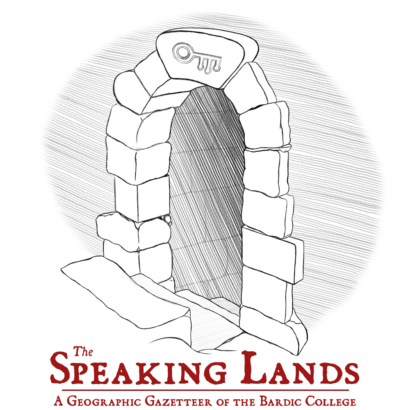Full disclosure, this is one of my favorite entries of the Gazetteer. I’ve got a soft spot for the people trying to figure out their world and share that knowledge with others. Frame that into an institution with a history and traditions of its own, and you’ve got me hook, line, and sinker.
One of my goals when writing this entry was to lay groundwork that would make bards a continental phenomenon. They’re a fantasy staple even though, historically speaking, the range of bards (and their nordic cousins, skalds) was rather limited. Making them both fashionable in courts and giving them mechanisms for organized deployment allowed me to quiet my own internal critic that questioned bards being as ubiquitous as fighters, clerics, or wizards.
And I can never resist an opportunity to make people academics, let’s be honest, here.
In any case, I hope you enjoy the Bardic College, because the bards train very hard to present themselves as enjoyable.
—
BARDIC COLLEGE
While there are many bardic schools and this one’s full name is The King’s Own Bardic Teaching College and Preservation Library of Dion, this institution is known to most of the Speaking Peoples as the Bardic College. Its campus in the northwestern city of Dion has trained bards both illustrious and modest and sent them out into the world to gather, promulgate, and preserve the legends and histories they find.
The college began as a humble archive created by satyr refugees seeking to preserve their own stories and culture after being displaced from the forests of Loratha. As the Sylvan Diaspora continued, more peoples arrived in Wildermarch, and their stories were added to the burgeoning archive. At first the archive was passed generation to generation through a process of apprenticeship, but as the archive grew, its needs became greater and more complex. This coincided with the ascendant reign of King Silenos I, who provided the funds to create an attached college to train archivist bards. Even though the Silenos dynasty collapsed three generations later, the college retained its “King’s Own” moniker thereafter.
The college developed a reputation for excellence such that foreign monarchs began hiring its graduates as court bards. These bards recorded the local stories at their postings and sent them back to Dion to add to the archive, often in the hands of promising young people who hoped to attend the college, themselves. The protocols and traditions of the Bardic College thus spread throughout the continent.
Chief among those protocols is the Bardic College’s strict delineation between legends and histories. Any story may be recognized, recorded, and spread as a legend, and most of these are explicitly fictional if not intentioinally allegorical. Those stories whose events can be corroborated with facts, written records, and close examination of physical relics may be accorded the status of history. While the distinction is not always appreciated by the audience, every bardic performance is explicit on whether it is presenting legend or history.
For example, the college has many stories about Asfixis. Some detail the construction of its twin cities and the political machinations over control over their trade links; having verified these stories as accurate, these are shelved as histories. The college also preserves a number of stories that explain how the Asfixis Caldera was formed, from accounts where an eldrich dragon sorcerer blew off the end of the mountain range to where an ancient King Under the Mountain had sufficiently epic gastrointestinal problems to accomplish the same. Lacking verification, these remain legends.
The college does not value its histories over its legends; if anything, they laud legends more because their details can be adjusted to suit an audience and better deliver their themes and morals. Histories are considered invaluable but less useful: they require specialized knowledge to interpret and significant storytelling techniques to deliver. The college has no shortage of bards who debate the relative merits back and forth. The most strident of these partisans might call themselves historians or folklorists, but at the end of the day, they are all bards.
The college has a complicated history with the Dread Tyrant, who rose to power in the neighboring Toriel Highlands. While his initial attempts to recruit the college as a propoganda machine were strenuously rebuffed, he was familiar enough with the college’s culture to turn them to his will without explicitly recruiting them. Instead, he sent reports of each of his atrocities to the college, along with traumatized eye witnesses to corroborate the stories. The college, believing it their duty to warn others of the Tyrant’s actions, sent these verified histories to their bards throughout the continent, spreading word of the implacable threat of the Tyrant to every court and city in the land. It was all the Tyrant ever wanted of them in the first place.
In hindsight, many bards believe they should have promulgated stories of resistence alongside the reports of the Tyrant’s atrocities, that no telling of stories can ever be apolitical. They, more than most, have many examples to suit, both from their historical archives and from their legendaria. After the fall of the Dread Tyrant, many bards believe they must set their stories to a new purpose: rebuilding the world such that it will never produce another Tyrant.
—
The bards are full of stories for you, which entry would you like them to recount next week?
